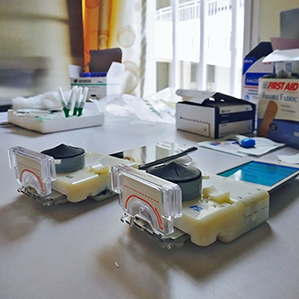Smartphone Test for HIV and Syphilis Costs Pennies
In a small trial in Rwanda, a $34 smartphone attachment rapidly and accurately detected the presence of HIV and syphilis antibodies in drops of blood taken from pregnant women. The work, described in a paper published today in the journal Science Translational Medicine, demonstrates that laboratory-quality diagnostics can be run on a pocket-sized device that works well in field conditions.

The plastic attachment, about the size of the phone itself, uses disposable cartridges costing just pennies. A health-care worker loads a blood sample, which mixes with chemicals called reagents in microscale channels within the cartridge.
Gold nanoparticles bind to antibodies, and silver nanoparticles form a film around the gold particles. This silver film blocks light shined through the finished sample, indicating the test result within 15 minutes. The result is automatically loaded into the phone’s storage.
The test replicates antibody-based tests known as ELISA but does not require expensive lab equipment. In the study, which involved 96 people, the accuracy was almost as good as it is with ELISA, says Samuel Sia, an assistant professor of biomedical engineering at Columbia, who led the work.
Several groups are working on similar microfluidic-chip technologies. A decade ago, Sia founded a startup, Claros Diagnostics—later sold to OPKO Health of Miami—to market a version of his system for prostate cancer tests (see “Prostate Cancer Results While You Wait” and “Innovators Under 35: Samuel Sia”).
In the past few years, members of Sia’s research group have miniaturized the technology, reduced its power requirements, and integrated it with everyday mobile devices. The tiny amount of current available in a smartphone audio jack is all that’s needed to power the sensing and data management. (One charge of an iPod Touch can power 41 tests.) “We sort of smartphoned it, in a way,” Sia says. “We’ve greatly reduced the size, cost, and power requirements.”
Sia’s group also created software that records the results of tests and upload those results to a server—a crucial function for data collection and retention. The group worked on HIV and syphilis markers as part of a USAID program on maternal health.
“This work is a proof of how technology can improve diagnosis and care, making it faster and simpler and cheaper without compromising the existing quality,” says Sabin Nsanzimana, the manager of the sexually transmitted disease division at Rwanda’s Ministry of Health. However, “it may take time, or bigger studies,” to see wider adoption, Nsanzimana says.
Sia says he is now planning a larger-scale field trial and sees far broader implications for smartphone-based diagnostics. “While we’ve been working on HIV and syphilis, this technology can be used for a variety of different applications, obviously,” he says. “You could see health-care systems transformed in a very fundamental way if consumers can get precise measurements in a decentralized manner.”
Keep Reading
Most Popular
Large language models can do jaw-dropping things. But nobody knows exactly why.
And that's a problem. Figuring it out is one of the biggest scientific puzzles of our time and a crucial step towards controlling more powerful future models.
The problem with plug-in hybrids? Their drivers.
Plug-in hybrids are often sold as a transition to EVs, but new data from Europe shows we’re still underestimating the emissions they produce.
Google DeepMind’s new generative model makes Super Mario–like games from scratch
Genie learns how to control games by watching hours and hours of video. It could help train next-gen robots too.
How scientists traced a mysterious covid case back to six toilets
When wastewater surveillance turns into a hunt for a single infected individual, the ethics get tricky.
Stay connected
Get the latest updates from
MIT Technology Review
Discover special offers, top stories, upcoming events, and more.